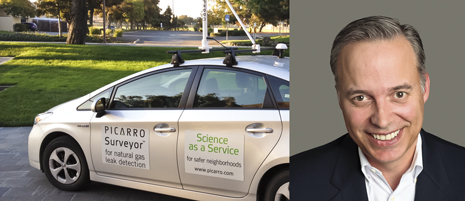Innovative thinkers
Michael Woelk: Leak detection hits the streets
|
For many, it came as a major shock, in April 2013, when the Environmental Protection Agency publically conceded that emissions from natural gas production were less than originally thought. While the revelation probably won’t do much to sway the more entrenched opponents of fossil fuels, it helps the industry make a case, to the public and government, for continuing to exploit U.S. shale gas reserves.
However, despite this good news, many outside the industry are still jaded from the Macondo crisis and even more recently, the Arkansas pipeline rupture. Though these incidents involved oil and not gas, their implications weigh heavily on the fate of fracing and a push for natural gas. With this challenge in mind, Michael Woelk, CEO of California instrument company Picarro, has been working to commercialize and develop a cheaper, more convenient way for companies to detect fugitive methane leaks. According to Woelk, an increased level of responsibility is necessary to sustain the momentum of shale gas production. The technology collects data by sending out a series of laser pulses, which reflect back to the device differently, depending on the chemical composition and volume of the object gas. This device is called a cavity ring-down spectrometer and has existed for years. These instruments have been used to analyze gases in the past, so even the application, itself, is nothing particularly new. Instead, it is the packaging and business model that Woelk and Picarro have developed, which distinguishes this version of CRDS from past iterations. According to Woelk, past methods of checking for methane leaks were cumbersome, slow and very rough on those tasked with making the measurements. “The traditional way is really a process of taking what might be a detector that weighs 20 lb,” said Woelk, “and go walk over every weld, seam, pump and compressor, within inches, and walk the whole facility.” This process looks even more frustrating, when one imagines the sheer amount of pipeline infrastructure in the U.S., alone. However, Picarro’s CRDS is not something to be lugged around by hand, but is, instead, loaded conveniently into the operator’s motor vehicle of choice. The car-mounted system allows users to drive alongside pipelines or other facilities needing review, while taking measurements at distances up to 1 km. Operators can view the leaks in real time on an iPad application, and, they never need to leave the car. Companies using the technology also have the option of streaming the real time data, so that other employees, off-site, can see the process remotely, via desktop, iPad, or even smartphone. Aside from increasing measurement efficiency, Woelk said that the Picarro Surveyor system also reduces costs, which in turn allows more companies to take advantage of the technology. Other CRDS units require highly-trained scientific technicians, to use them at all, significantly bumping up the cost of taking measurements like these. “People that have less training are less expensive to hire than highly educated people, who have more training. These ones scale very easily, while the other is much more painful and costly to scale because there are fewer highly educated people in the world, like atmospheric physicists,” said Woelk. Any person, scientist or otherwise, can use the unit without intensive scientific training. Other cost-savings include the detection of leaks themselves, which, in addition to incurring the ire of the EPA, hemorrhage profit, over long-enough periods of time. Woelk says that this instrument, which consists of the same technology that UN scientists use in their own greenhouse gas studies, holds the promise of potentially being able to bring more credibility to the oil and gas industry, among the rational public and even some environmentalists. |
- Applying ultra-deep LWD resistivity technology successfully in a SAGD operation (May 2019)
- Adoption of wireless intelligent completions advances (May 2019)
- Majors double down as takeaway crunch eases (April 2019)
- What’s new in well logging and formation evaluation (April 2019)
- Qualification of a 20,000-psi subsea BOP: A collaborative approach (February 2019)
- ConocoPhillips’ Greg Leveille sees rapid trajectory of technical advancement continuing (February 2019)



